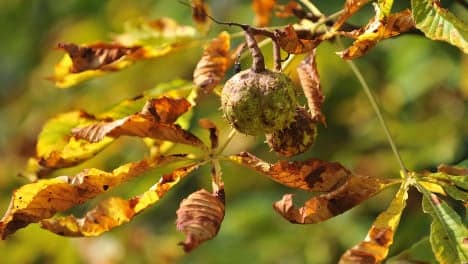Experts ask Germans to help save chestnut trees from moths

As autumn sets in, experts are asking Germans to carefully collect chestnut tree leaves to protect the beloved biergarten fixtures from a growing moth problem.
According to the Bonn-based SDW, a German forest protection association, there is no way to eliminate the spreading plague of invasive of leaf miner moths (Cameraria ohridella), which cause the chestnut trees to begin shedding their leaves prematurely in the summer.
But fastidiously collecting the fallen leaves – then burning or burying them deep in the ground – reduces the number of moths, and gives the trees more time to recover in the next year before they face another attack, SDW said.
The pests are particularly drawn to the horse chestnut trees, which are known for the friendly shade they provide at German beer gardens across the country.
“We do not know of a tree that has died because of the leaf miner moths,” Julius Kühn Institute botanist Gerlinde Nachtigall said.
But infestation over many years does stress the trees, resulting in slower growth, the institute reported. The SDW said the trees also become more vulnerable to fungi and other pests.
“Many places report heavier or equal infestations to last year, while in some it seems better,” SDW spokesperson Jens Stengert said. “We want to help the chestnut trees get better again.”
Last year some 350 communities worked to clear chestnut tree leaves to fight the moths and this year the SDW is hoping for more than 500 to take part in the national day of action on November 14.
The Cameraria ohridella was first detected in Macedonia in 1984. It has slowly made its way north since then, infesting chestnut trees across Germany starting in 2005.
The moths that survive the winter lay eggs on young leaves in the spring. Hatched larvae feed on the leaves for some two weeks before they form a cocoon and hatch as moths two weeks later to begin the process anew for up to four generations each season.
Several methods have been employed to fight the infestation, but most have been either too expensive or infeasible.
Comments
See Also
According to the Bonn-based SDW, a German forest protection association, there is no way to eliminate the spreading plague of invasive of leaf miner moths (Cameraria ohridella), which cause the chestnut trees to begin shedding their leaves prematurely in the summer.
But fastidiously collecting the fallen leaves – then burning or burying them deep in the ground – reduces the number of moths, and gives the trees more time to recover in the next year before they face another attack, SDW said.
The pests are particularly drawn to the horse chestnut trees, which are known for the friendly shade they provide at German beer gardens across the country.
“We do not know of a tree that has died because of the leaf miner moths,” Julius Kühn Institute botanist Gerlinde Nachtigall said.
But infestation over many years does stress the trees, resulting in slower growth, the institute reported. The SDW said the trees also become more vulnerable to fungi and other pests.
“Many places report heavier or equal infestations to last year, while in some it seems better,” SDW spokesperson Jens Stengert said. “We want to help the chestnut trees get better again.”
Last year some 350 communities worked to clear chestnut tree leaves to fight the moths and this year the SDW is hoping for more than 500 to take part in the national day of action on November 14.
The Cameraria ohridella was first detected in Macedonia in 1984. It has slowly made its way north since then, infesting chestnut trees across Germany starting in 2005.
The moths that survive the winter lay eggs on young leaves in the spring. Hatched larvae feed on the leaves for some two weeks before they form a cocoon and hatch as moths two weeks later to begin the process anew for up to four generations each season.
Several methods have been employed to fight the infestation, but most have been either too expensive or infeasible.
Join the conversation in our comments section below. Share your own views and experience and if you have a question or suggestion for our journalists then email us at [email protected].
Please keep comments civil, constructive and on topic – and make sure to read our terms of use before getting involved.
Please log in here to leave a comment.